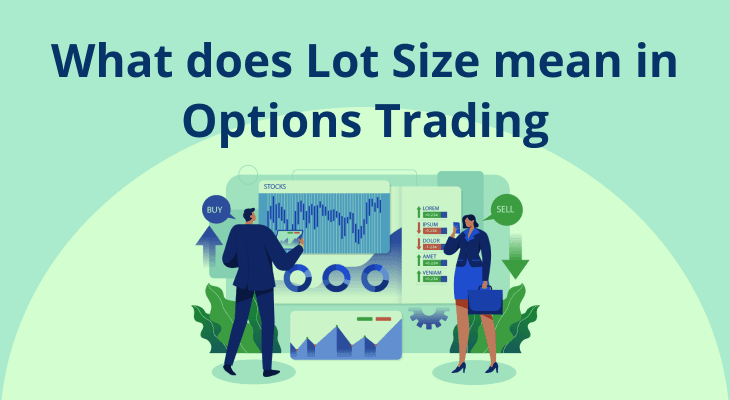
What Is Synthetic Trading In F&O?
Futures and Options (F&O) trading is a popular segment of the derivatives market that offers traders tools to hedge, speculate, or enhance their portfolio efficiency. As you look further into F&O strategies, you may come across the term synthetic trading, a concept that is less commonly utilised, yet powerful when applied correctly.
In the financial world, “synthetic” refers to a strategy or instrument engineered to replicate the payoff or behaviour of another financial position. Instead of taking a direct position in a stock or future, synthetic trading allows the trader to mimic that exposure using a combination of options or other derivatives.
This approach does not involve the physical purchase or sale of the underlying asset. Rather, it relies on options (calls and puts) structured in specific ways to replicate a desired outcome. For example, buying a call and selling a put at the same strike price can replicate owning the underlying stock. This is how synthetic positions work in practice.
In the Indian markets, where liquidity, taxes, and margin considerations are critical, synthetic trading in F&O can be a strategic tool for active traders. If you understand the components and risks involved, it can offer a cost-effective way to gain or hedge exposure.
Why Are Synthetic Positions Created?
Synthetic trading strategies are created for several reasons. Some of the most common include:
1. Capital Efficiency
Synthetic positions can replicate the payoff of a stock or future without tying up large amounts of capital. This allows you to maintain liquidity for other trades or investment opportunities.
2. Hedging
You may wish to hedge a current position without adjusting your actual holdings. A synthetic structure can protect against downside or upside movement while keeping the underlying intact.
3. Market Access
Sometimes, borrowing restrictions or regulatory constraints may prevent you from shorting a stock directly. In such cases, synthetic short positions offer a workaround using options.
4. Tax and Cost Considerations
Synthetic trades may lead to different tax treatments or transaction costs when compared to traditional positions. In certain scenarios, they can be more tax-efficient, especially under Indian taxation rules for derivatives.
5. Customisation
You can customise synthetic structures to suit your view on volatility, direction, and time - flexibility that standard stock or futures positions may not always offer.
Core Types Of Synthetic Positions In F&O
Let us explore the most commonly used synthetic positions in F&O. Each one involves a unique combination of options (and sometimes stock), designed to simulate the profit/loss structure of another asset or derivative.
A. Synthetic Long Stock (Synthetic Call)
- Structure: Buy a Call + Sell a Put (Same strike, same expiry)
- Purpose: Mimics a long stock position
- Used When: You are bullish on the stock and want exposure without buying the stock directly
This strategy behaves like owning the stock. If the stock price rises above the strike price, you gain. If it falls, you may face losses, similar to holding the stock.
B. Synthetic Short Stock (Synthetic Put)
- Structure: Sell a Call + Buy a Put (Same strike, same expiry)
- Purpose: Mimics a short stock position
- Used When: You expect the price to decline but cannot short-sell the stock directly
This allows you to profit from falling prices without borrowing the stock.
C. Synthetic Call (Long Stock + Long Put)
- Structure: Buy Stock + Buy Put
- Purpose: Mimics a long call option
- Used When: You want protection on your long position and expect limited downside risk
The put limits your downside, while the stock gives you upside exposure, resembling a call.
D. Synthetic Put (Short Stock + Long Call)
- Structure: Sell Stock + Buy Call
- Purpose: Mimics a long put
- Used When: You are bearish but want to limit the upside risk if prices move against your short
The call acts as insurance in case the stock moves higher.
Examples & Payoff Diagrams
To better understand synthetic trading, it’s important to look at how each structure behaves in real-market conditions. This section provides six detailed examples, showing the components, outcomes, and payoff diagrams for each synthetic position.
Assumptions for all examples:
- Strike Price = ₹ 1,000
- Lot Size = 1
- Call Premium = ₹ 40
- Put Premium = ₹ 30
- Stock Price at Expiry: Ranges from ₹ 950 to ₹ 1,050
- Same expiry for all options
1. Synthetic Long Stock (Long Call + Short Put)
- Structure:
- Buy 1 Call Option @ ₹ 1,000 = ₹ 40 (Premium Paid)
- Sell 1 Put Option @ ₹ 1,000 = ₹ 30 (Premium Received)
- Net Cost = ₹ 10 (outflow)
Purpose: To mimic buying the underlying stock without actually owning it.
Stock Price at Expiry | Call P&L | Put P&L | Net P&L |
|---|---|---|---|
₹950 | 0 | -₹50 | -₹50 - ₹10 = -₹60 |
₹1,000 | 0 | 0 | -₹10 |
₹1,050 | +₹50 | 0 | ₹50 - ₹ 10 = ₹40 |
2. Synthetic Short Stock (Short Call + Long Put)
- Structure:
- Sell 1 Call Option @ ₹ 1,000 = ₹ 40 (Premium Received)
- Buy 1 Put Option @ ₹ 1,000 = ₹ 30 (Premium Paid)
- Net Credit = ₹ 10 (inflow)
Purpose: To simulate a short sale without borrowing stock.
Stock Price at Expiry | Call P&L | Put P&L | Net P&L |
|---|---|---|---|
₹ 950 | 0 | +₹ 50 | ₹ 50 + ₹ 10 = ₹ 60 |
₹ 1,000 | 0 | 0 | ₹ 10 |
₹ 1,050 | -₹ 50 | 0 | -₹ 50 + ₹ 10 = -₹ 40 |
3. Synthetic Long Call (Long Stock + Long Put)
- Structure:
- Buy 1 Stock @ ₹ 1,000
- Buy 1 Put Option @ ₹ 1,000 = ₹ 30 (Premium Paid)
Purpose: Provides limited downside (due to put) while retaining full upside, behaves like a long call.
Stock Price at Expiry | Stock P&L | Put P&L | Net P&L |
|---|---|---|---|
₹950 | -₹50 | +₹50 | 0 - ₹30 = -₹30 |
₹1,000 | 0 | 0 | -₹30 |
₹1,050 | +₹50 | 0 | ₹50 - ₹30 = ₹20 |
4. Synthetic Short Call (Short Stock + Short Put)
- Structure:
- Sell 1 Stock @ ₹1,000
- Sell 1 Put Option @ ₹1,000 = ₹30 (Premium Received)
Purpose: Mimics the payoff of selling a call option.
Stock Price at Expiry | Stock P&L | Put P&L | Net P&L |
₹950 | +₹ 50 | -₹ 50 | 0 + ₹30 = ₹30 |
₹1,000 | 0 | 0 | ₹30 |
₹1,050 | -₹50 | 0 | -₹50 + ₹30 = -₹20 |
5. Synthetic Long Put (Short Stock + Long Call)
- Structure:
- Sell 1 Stock @ ₹1,000
- Buy 1 Call Option @ ₹1,000 = ₹40 (Premium Paid)
Purpose: Creates the same risk/reward profile as buying a put.
Stock Price at Expiry | Stock P&L | Call P&L | Net P&L |
|---|---|---|---|
₹950 | +₹50 | 0 | ₹50 - ₹40 = ₹10 |
₹1,000 | 0 | 0 | -₹40 |
₹1,050 | -₹50 | +₹50 | 0 - ₹40 = -₹40 |
6. Synthetic Short Put (Long Stock + Short Call)
- Structure:
- Buy 1 Stock @ ₹ 1,000
- Sell 1 Call Option @ ₹ 1,000 = ₹ 40 (Premium Received)
Purpose: Replicates the payoff of selling a put — limited upside, significant downside.
Stock Price at Expiry | Stock P&L | Call P&L | Net P&L |
|---|---|---|---|
₹950 | -₹50 | 0 | -₹50 + ₹40 = -₹10 |
₹1,000 | 0 | 0 | ₹40 |
₹1,050 | +₹50 | -₹ 50 | 0 + ₹40 = ₹40 |
Advantages Of Synthetic Trading
- Capital Efficiency: Synthetic structures usually require lower margin than holding the stock outright. This can free up cash.
- Flexibility: You can construct tailored positions, long, short, protected based on your market view.
- Liquidity: F&O contracts, especially in index options (like NIFTY and BANKNIFTY), are highly liquid, making entry and exit easier.
- Hedging Capabilities: You can use synthetics to hedge portfolios or manage risk exposure more precisely.
- Cost Savings: Avoid delivery charges, taxes like STT on delivery-based trades, and demat-related expenses.
Risks & Considerations
Despite the benefits, synthetic trading involves risks:
- Margin Requirements: Although often lower, synthetic positions still attract margin obligations under SEBI regulations. For instance, short options require upfront SPAN + Exposure margins.
- Assignment Risk: In certain stock options, there is a possibility of early assignment on short positions, where the buyer may exercise the contract before expiry.
- Bid-Ask Spreads: In less liquid stocks, wide spreads can eat into your profits.
- Complexity: These are not beginner-friendly strategies. If you miscalculate, it could lead to losses.
- Implied Volatility Sensitivity: Option premiums change with volatility. Sudden shifts in implied volatility can impact payoff.
When Should You Use Synthetic Trading?
Synthetic trading strategies are not for every market condition. You should consider them:
- When you cannot or do not wish to hold physical stock
- If you're looking to create directional bets without capital-intensive positions
- To hedge a position without disturbing your portfolio
- When arbitrage opportunities arise between synthetic and actual prices
- To benefit from volatility mismatches
For example, if you're bullish on Reliance but the share price is at a resistance level, you might use a synthetic long to benefit from upside while reducing capital usage.
Step-by-Step Guide To Implement Synthetic Trading
- Identify Your Objective
Are you replicating a long position, short position, or hedging? - Select Underlying Asset
Use highly liquid stocks or indices like NIFTY, BANKNIFTY, etc. - Choose the Right Strike Price & Expiry
Match strikes for components in the synthetic position. - Check Margins
Use NSE’s margin calculator to determine margin impact. - Execute Orders Carefully
Simultaneously place orders, or use combo order facilities if available. - Monitor Position
Track delta, gamma, and P&L regularly. - Exit or Adjust
If markets move sharply, you may need to rebalance or exit.
Comparison Table Of Synthetic Strategies
Strategy | Components | Mimics | Upside | Downside |
|---|---|---|---|---|
Synthetic Long Stock | Long Call + Short Put | Long Stock | Unlimited | Large (limited to strike - premiums) |
Synthetic Short Stock | Short Call + Long Put | Short Stock | Large (if price drops) | Unlimited |
Synthetic Call | Long Stock + Long Put | Long Call | Unlimited | Limited (to put premium) |
Synthetic Put | Short Stock + Long Call | Long Put | Large (if price falls) | Limited (to call premium) |
Conclusion
Synthetic trading in F&O offers you a versatile and capital-efficient way to participate in the market. By constructing combinations of options and stocks, you can replicate positions without physically buying or selling the underlying. However, this approach is not without complexity. It demands a sound understanding of option mechanics, margin implications, and market conditions. If used wisely, synthetic market trading can be an effective tool for the experienced synthetic trader looking to optimise returns, reduce capital deployment, or hedge intelligently.
FAQ
How does synthetic trading work in futures and options?
Synthetic trading in F&O works by combining call and put options (sometimes with stock/futures) to recreate the profit/loss structure of another asset. For example, a synthetic long stock is created by buying a call and selling a put at the same strike price and expiry.
What are the tax implications of synthetic trading?
Profits and losses from synthetic trading (being built entirely from exchange-traded futures and options) are classified as non-speculative business income under Section 43(5). You must report them under “Profits & Gains of Business or Profession” and pay tax at your slab rate. Standard levies like STT, GST on brokerage, exchange and SEBI charges apply to each leg of the strategy.
What is the difference between a real and synthetic position?
A real position involves directly buying or selling a stock or future. A synthetic position achieves the same financial result using derivatives. For example, instead of buying stock, you can replicate it using a long call and short put.
What is a synthetic short position?
It is a strategy that mimics shorting a stock. You construct it by selling a call and buying a put with the same strike and expiry. It benefits if the underlying price falls.
Can synthetic trading be used in all market conditions?
Not always. It is best used in trending or volatile markets. In range-bound markets, the premiums paid/received might erode profits.
Are synthetic trades margin-friendly?
They can be. For example, a synthetic long position usually requires lower margins than holding the stock outright, but margins can still be substantial depending on the components.
What happens if I get assigned early in a synthetic trade?
If the short option is exercised before expiry, it can break the structure of your synthetic position. It's important to monitor your trades closely and manage the risk of early assignment, particularly when dealing with stock options.
Can I use synthetic trading for intraday trades?
Yes, though it is more common in positional trades. Intraday synthetic positions may not allow enough time for payoffs to materialize due to time decay.
Which tools help implement synthetic trading strategies?
You can use option chain analysis, payoff calculators, and trading platforms offering strategy builders.
Is synthetic trading legal in India?
Yes, synthetic trading using exchange-traded options is fully legal and regulated by SEBI. Ensure you meet margin and compliance requirements while trading.


